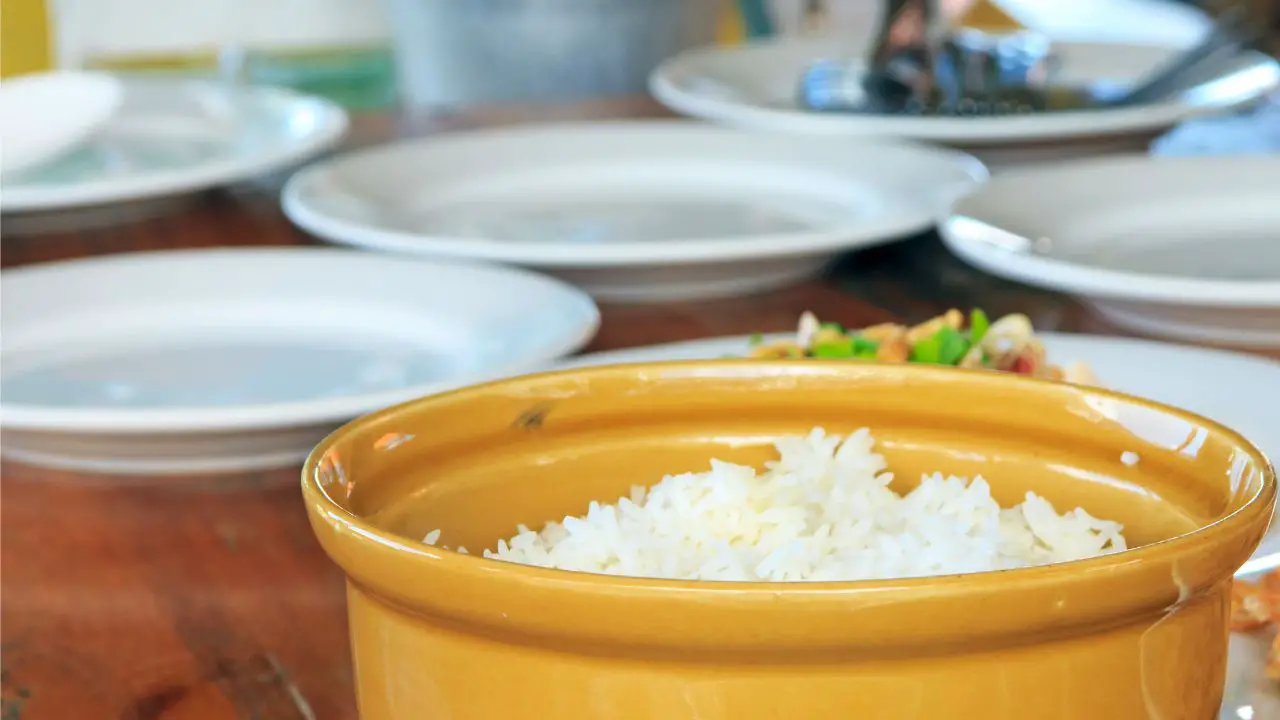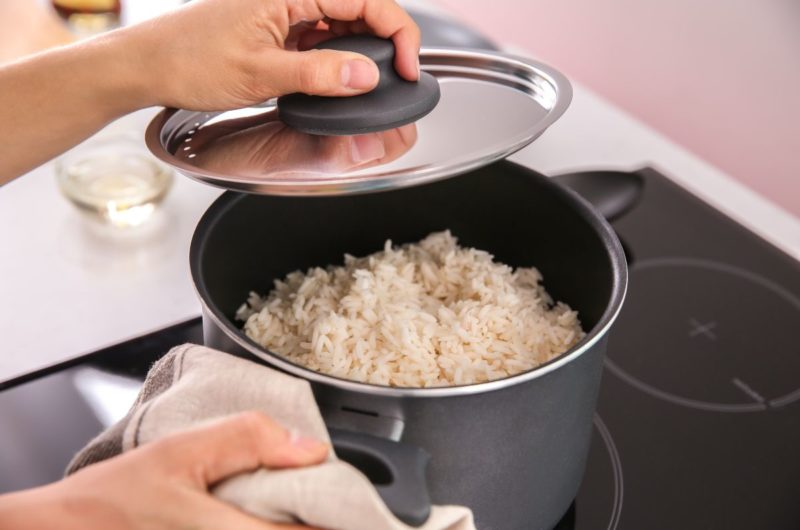If you don’t cook rice that often, making the correct amount of rice for each person can be tricky, especially if you are cooking for a larger group. Although it is pretty simple in theory, you still often end up with too much or too little rice.
Fortunately, there are some helpful tips and tricks to help you reach that perfect portion size.
Firstly, figuring out the perfect amount of rice for one person, you can then scale it up to suit ten people or more.
In this article, I will cover how much Long-grain white rice, Basmati, Arborio, Brown, Jasmine, Bomba, Sticky rice, and Wild rice you will need to feed 10 people.
What To Consider When Measuring Rice?
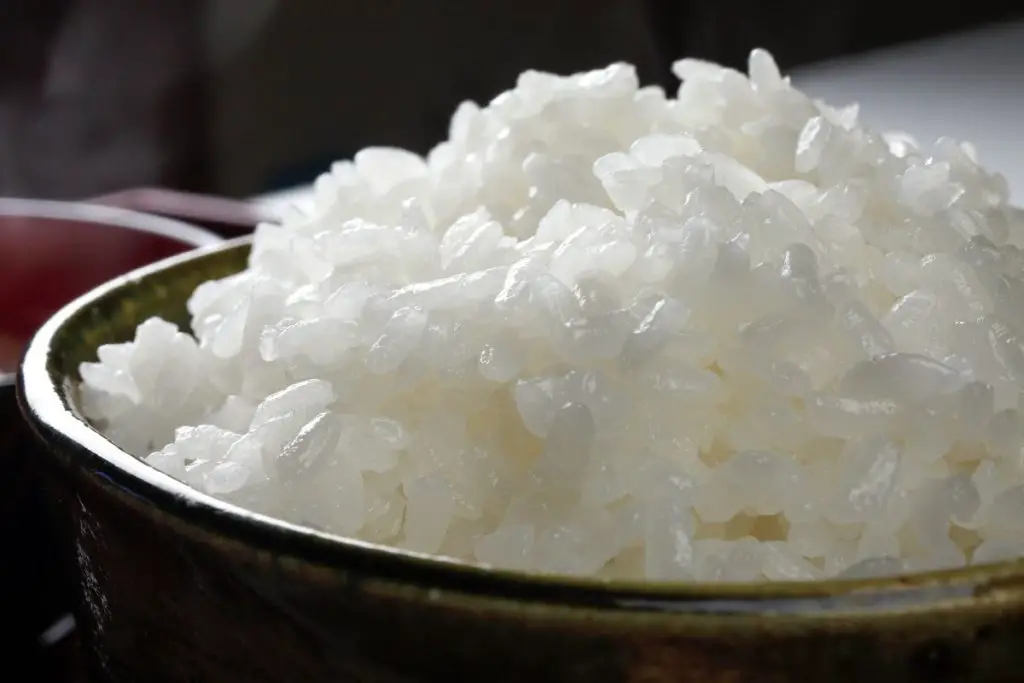
The most crucial aspect to consider when measuring rice is that it increases in size after being cooked. As such, what may seem like a small amount of rice when uncooked can realistically serve as an entire portion for a single adult after it finishes cooking.
Likewise, each rice type has unique characteristics and must be measured accordingly. Some types swell more when cooked than others, making it hard to provide one-size-fits-all measurements without addressing each strain.
What Is The Average Cooked Rice Serving Size For 10 People?
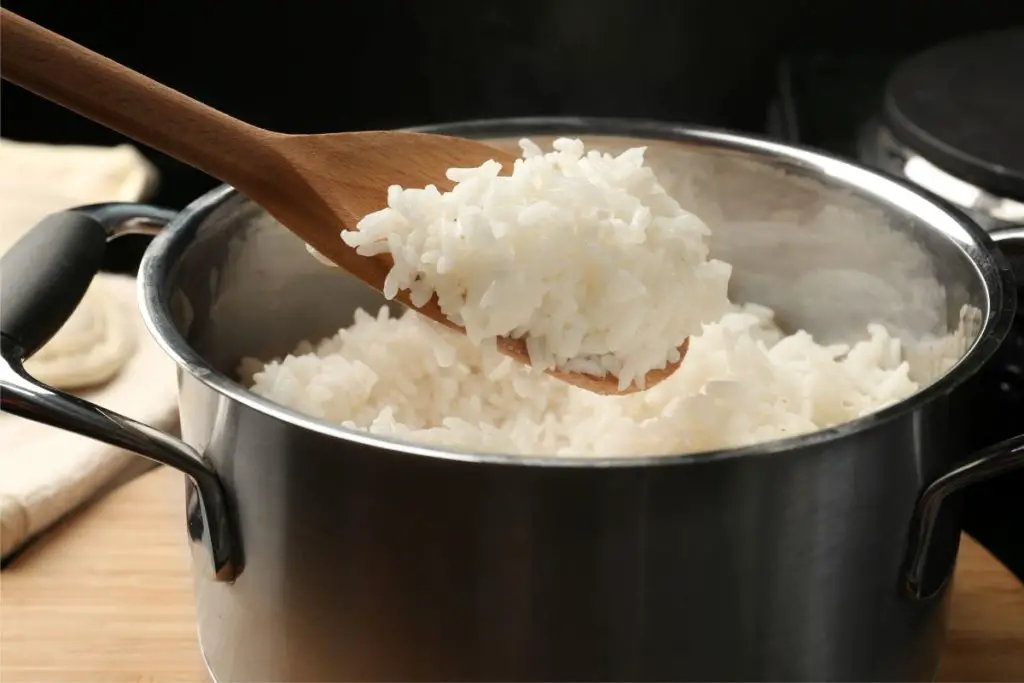
Let’s be honest—some people eat a lot, and some don’t. As such, it’s hard to establish a single universal serving portion size. Likewise, the amount of rice you need always depends on whether it is a side dish or the main course.
On average, approximately ½ cup (125 g) of cooked rice is enough as a side dish for one person, while a full cup (250 g) can function as the main dish. Subsequently, cooking rice as a side dish for ten people will require five cups (1,250 g) of cooked rice, while 10 cups (2,500 g) would be the minimum if rice is the main dish.
But that refers to cooked rice quantities—how do you know the amount of uncooked rice you require?
How Many Cups Of Rice For 10 People? (Uncooked)
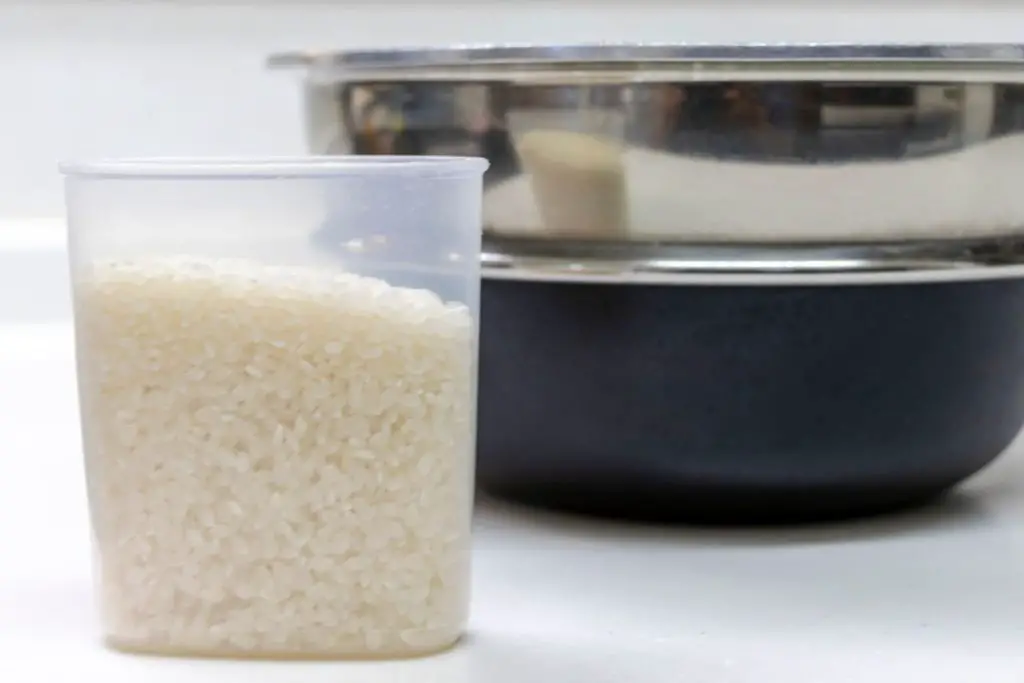
Cooking rice is not an exact science, which is why so many people and cultures have their take on the practice. However, it’s safe to assume that most rice doubles in size after cooking unless specified otherwise.
If you follow that logic, you’ll find it easier to calculate the amount of uncooked rice you need. It’s as simple as estimating the amount of cooked rice you need and cutting the number by half.
Uncooked Rice Measurements For 1 Serving
- ¼ cup (50 g) of uncooked rice as a side dish.
- ½ cup (100 g) of uncooked rice as the main course.
Uncooked Rice Measurements For 10 Servings
- 2 ½ cups (500 g) of uncooked rice as a side dish.
- 5 cups (1,000 g) of uncooked rice as the main course.
As such, cooking rice as a main dish for 10 people would require approximately 5 cups (1,000 g) of uncooked rice. This rule applies to nearly all rice strains (except wild rice, see below), but you’re free to adjust the proportions according to the dish you want to cook—and the appetite of your guests!
However, although the cup measurements don’t usually change between rice strains, the cooking methods do.
Converting Cup Of Rice To Grams
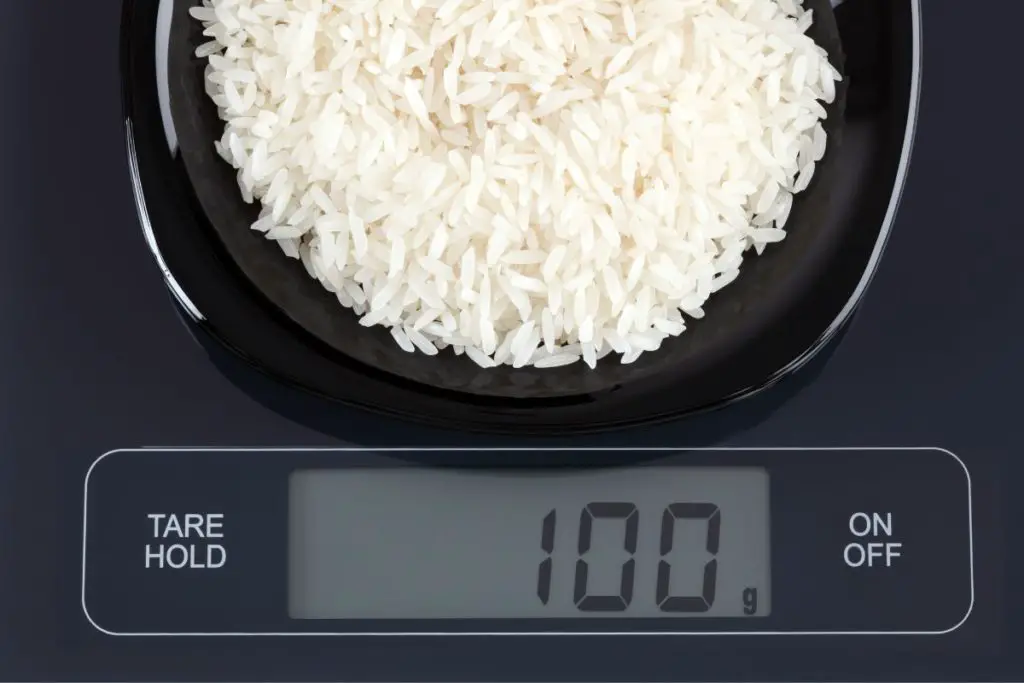
For those cooking outside the US, particularly in the UK, it’s difficult to convert cups to the more widely-used measurement of grams. Cups measure volume, while grams measure weight. As such, it’s difficult to find a precise comparison.
Rounding it to an easy-to-remember round number, ½ cup of dry rice equals 100g. Cooking rice is not a uniform process that is ever precisely replicated, nor is the conversion of measurement an exact sum, but you should at least always end up with an appropriate amount
Read Also: 6 Compelling Reasons to Rinse Your Rice Before Cooking!
Why Do Different Rice Strains Cook Differently?
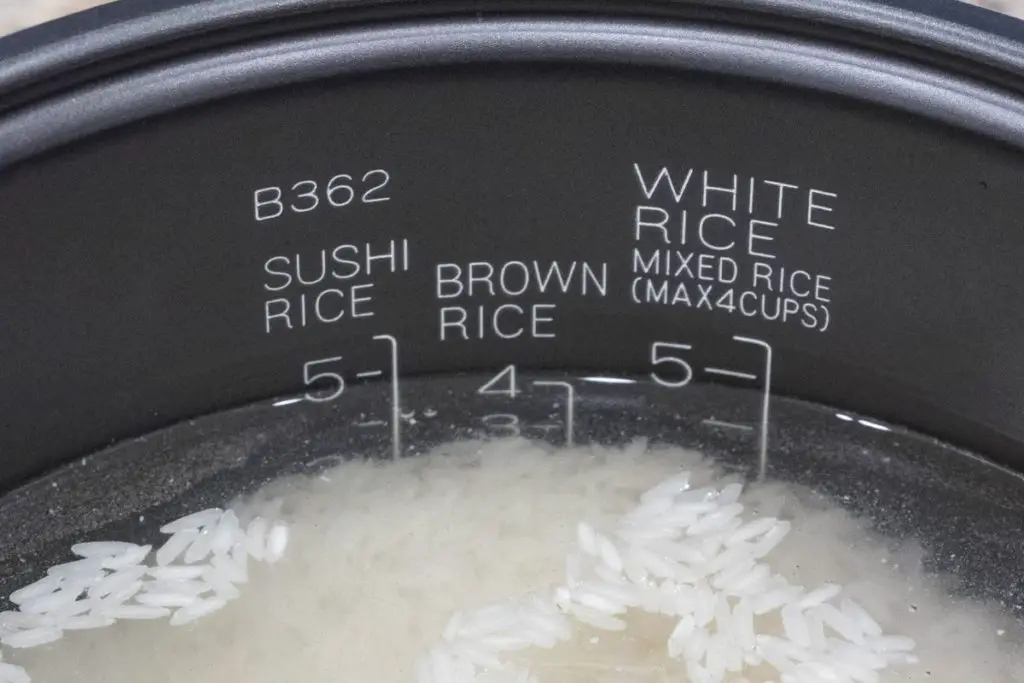
When you cook rice, you’re activating two different processes: the grains absorb the water and increase in size, and the heat softens the starch in each grain and turns it softer and fluffier. [1]
However, the different rice strains available vary in size and starch content. Naturally, this means they react differently when cooked. The starchier varieties will turn very soft and sticky, while the shorter strains will not increase that much in size. [2]
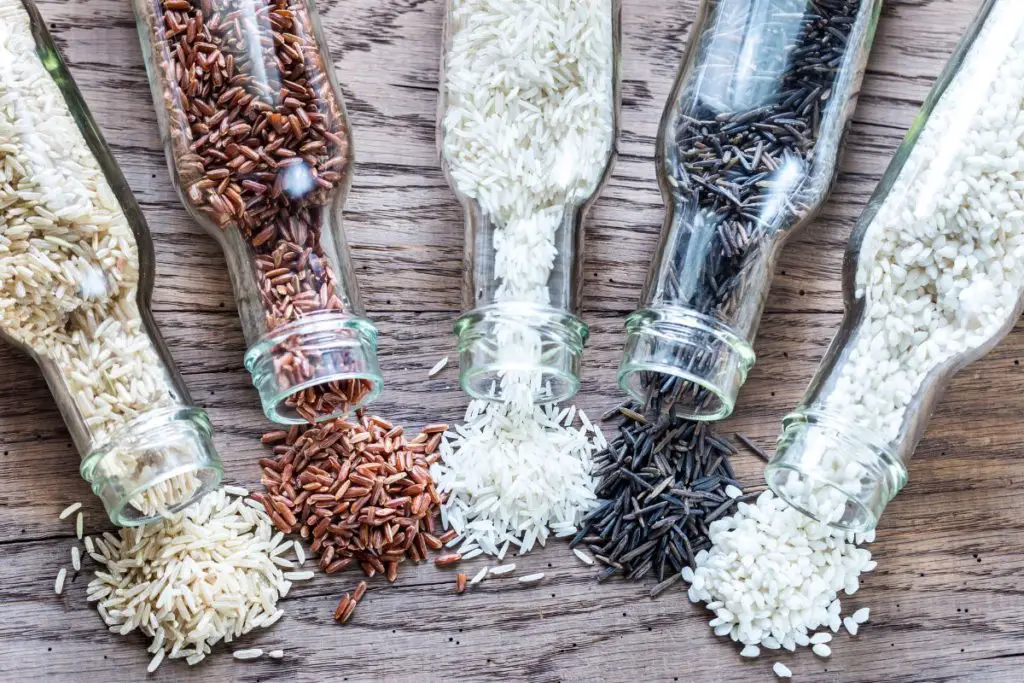
That is why different strains require different measures, rice-to-water ratio, and cooking processes.
1. Long Grain White Rice
Long-grain white rice stands out due to its relatively low starch content, which means that—if cooked properly—it should be dry, fluffy, and not sticky at all. It is excellent to enjoy as a side dish, but it’s not suitable for risotto, paella, or sushi.
Cooking long-grain white rice requires a 2:1 liquid-to-rice ratio. This means that you’ll need two parts of water or liquid per every single part of rice—for example, each cup of rice (200 g) will require two cups of water (473 ml) to cook.
2. Basmati Rice
Fragrant and flavorful, basmati rice boasts a floral aroma and a slightly nutty taste. Due to its fluffy yet clear texture, basmati rice quickly soaks up on sauces, making it an ideal companion for pilaf, curry, and other sauces.
To prepare basmati rice, you need 1 ½ cups of water (355 ml) per cup of uncooked rice (200 g). This means that to cook enough rice for 10 people to enjoy as the main dish, you’ll need 5 cups of basmati rice (1,000 g) and 7 ½ cups (1,7 L) of water.
3. Arborio Rice
Arborio rice is short-grain rice with Italian origins, known for being the strain required to make traditional risotto recipes.
Unlike the previous varieties, arborio rice has high levels of starch named amylopectin. When cooked, it absorbs liquid and releases its starch, turning chewier and creamier.
Since it is reserved for risotto, giving arborio rice its creamy consistency requires plenty of liquid, usually stock. Although it varies per recipe, the liquid-to-rice ratio indicates 4 cups of liquid (946 ml) per single cup of rice. This means that to cook risotto for 10 people, you would need 5 cups of rice (1,000 g) and 20 cups of liquid (4,7 L).
4. Long Grain Brown Rice
Brown rice is a whole grain since it contains the germ and the bran. Subsequently, it has higher levels of fiber, antioxidants, and vitamins and minerals such as B1, B3, B6, magnesium, and phosphorus.
However, due to this structure, long-grain brown rice takes longer to cook than white rice and thus requires a bit more water. The ideal ratio is 2 ½ cups of water (590 ml) per cup (200 g) of uncooked rice.
Read Also: How To Make Brown Rice Sticky For Sushi (Plus 5 Whole Grain Sushi Recipes).
5. Jasmine Rice
Another aromatic rice strain, jasmine rice is somewhat sweet and boasts of a popcorn-like fragrance and a slight buttery touch. Although its white variety may look similar to jasmine and long-grain white rice, it is about three times stickier and comes in plenty of colors.
Popular to use for stir-fries or curries, jasmine rice requires 2 cups (473 ml) of liquid per cup (200 g) of uncooked grains. However, if you prefer it to be more al dente, 1 ½ cups (355 ml) of liquid is good.
6. Bomba Rice
Short and slightly round, Bomba rice is the perfect paella rice. Cultivated in the Spanish region of Valencia, it can absorb over three times its volume in water, but it remains non-sticky thanks to its high levels of amylose (a component of starch).
Since Bomba rice can absorb water readily, it requires higher liquid levels when cooking. As such, it has a liquid-to-rice ratio of 3:1, which means that to prepare a delicious paella for 10 people, you’d need 5 cups (1,000 g) of Bomba rice and 15 cups (3.5 L) of stock.
7. Sticky Rice
Also called glutinous or sweet rice, this variety is common in the cuisine of countries such as Thailand, China, and Japan. The name is pretty indicative—this rice is very sticky and glue-like.
The preparation method for sticky rice is vastly different from other varieties. For starters, the rice needs to be soaked in water for at least 6 hours before cooking, and it is not boiled but steamed, approximately for 10 to 20 minutes.
8. Wild Rice
A grain native to North America, wild rice boasts a firm texture and a nutty flavor. More importantly, it is rich in vitamins B, vitamin E, vitamin K, iron, calcium, magnesium, potassium, and fiber, making it a healthy alternative to white rice.
Surprisingly, it can grow up to three times its original size, so the general rule for serving portions does not apply to wild rice. As a rule, one cup (160 g) of uncooked wild rice can transform into three cups once boiled, which means that 1/3 cup (53 g) will make a full cup of cooked rice—a whole main course portion for an adult person.
Subsequently, when cooking for 10 people, you’d have to cook 3 1/3 cups (533 g) of wild rice for a main course meal and about 1 ½ cups (240) to provide a rice side dish for 10.
In Summary
So, knowing that rice approximately doubles in size during cooking and that a suitable portion per person is 1 cup of cooked rice, you need ½ cup of dry rice for each person.
Generally speaking, rice measurements can be directly scaled up without error. Therefore, a sensible amount to measure out for 10 people is 5 cups of uncooked rice.
Of course, appetites and preferences differ, but sticking to this as a guide should ensure no one goes hungry.
References:
- [1] Joachim, David & Schloss, Andrew (n/d). The Science of Cooking Rice. Retrieved from https://www.finecooking.com/article/the-science-of-cooking-rice.
- [2] Corriher, Shirley. (n/d). Starch Makes Rice Sticky or Fluffy. Retrieved from https://www.finecooking.com/article/starch-makes-rice-sticky-or-fluffy.
